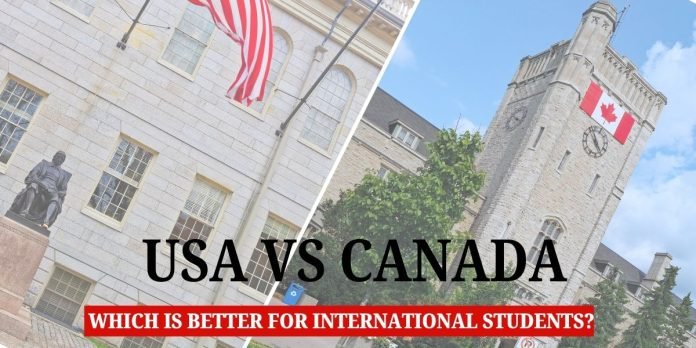Overall verdict:
-
Choose Canada if you want affordability, post-study work opportunities, and a clearer path to permanent residency.
-
Choose the USA if you prioritize university prestige, program diversity, and high-paying job opportunities, especially in STEM and business.
🇺🇸 USA vs 🇨🇦 Canada: Key Comparison Table
| Category | USA | Canada |
|---|---|---|
| Academic Reputation | Ivy League & top 10 global rankings (Harvard, MIT, Stanford) | Global top 50 universities (Toronto, UBC, McGill) |
| Tuition Fees (Per Year) | $20,000–$60,000 | $15,000–$40,000 |
| Cost of Living | $1,500–$3,000/month (high in NYC, LA) | $1,200–$2,500/month (lower in cities like Ottawa, Calgary) |
| Language Requirements | IELTS/TOEFL often required; some accept WAEC English | IELTS/TOEFL usually required; more schools accept WAEC English |
| Visa Type | F-1 (with SEVIS, I-20) | Study Permit (SDS or regular stream) |
| Work During Study | 20 hrs/week on-campus; OPT/CPT after studies | 20 hrs/week on/off-campus; PGWP up to 3 years |
| Post-Graduation Work | OPT (12 months, +24 months STEM) | PGWP (up to 3 years) |
| Pathway to PR | Difficult, tied to H-1B lottery, employer sponsorship | Clearer PR path via Express Entry, CEC, and PNPs |
| Scholarship Availability | Extensive (Fulbright, Stanford, AU, etc.) | Fewer but strong (Vanier, Lester B. Pearson, York, etc.) |
| Visa Refusal Rate | Higher (due to strict proof of funds & ties to home country) | Lower (especially via SDS stream with proper documentation) |
🧠 Academic Excellence
-
USA leads globally in reputation, innovation, and research facilities.
-
Canada offers competitive programs with practical, industry-relevant learning—particularly strong in healthcare, AI, and environmental science.
💸 Tuition & Cost of Living
-
USA: Tuition is higher. Top private schools can exceed $60,000/year.
-
Canada: More affordable. Graduate programs typically range from $20,000–$40,000/year.
Living Costs:
-
USA: High in metro areas (e.g. NYC, LA).
-
Canada: Cities like Toronto are expensive, but places like Halifax or Winnipeg are budget-friendly.
🎓 Admission & Visa Requirements
USA:
-
Standardized tests (SAT, GRE, GMAT) more common
-
SEVIS fee + F-1 visa + proof of funds ($10,000–$15,000+)
Canada:
-
Less reliance on SAT/GRE
-
SDS Visa option allows faster processing with:
-
Tuition paid
-
$10,000 GIC
-
IELTS 6.0+ in each band
-
🧾 Scholarships & Financial Aid
Top USA Scholarships:
-
Fulbright (fully funded)
-
Stanford University Aid
-
AU Emerging Global Leader Scholarship
-
Hubert Humphrey Fellowship
Top Canada Scholarships:
-
Vanier Graduate Scholarship ($50k/year)
-
Lester B. Pearson Scholarship (UG, fully funded)
-
York University Int’l Scholarships ($60k–$100k)
💼 Work and PR Opportunities
USA:
-
OPT: 12 months post-study
-
STEM OPT: Extra 24 months
-
PR Path: Mainly through employer sponsorship and H-1B lottery (competitive)
Canada:
-
PGWP: Up to 3 years
-
PR Path: Easier via Express Entry, Canadian Experience Class, Provincial Nominee Programs (PNPs)
🏁 Final Thoughts: USA vs Canada
| Choose USA If You Want… | Choose Canada If You Want… |
|---|---|
| Prestige, global rankings, and Ivy League education | Lower tuition and cost of living |
| Access to top-tier internships and high-salary US tech firms | Post-graduation work and easy PR path |
| Strong industry links in finance, business, and tech | Multicultural, student-friendly environment |
| Abundant funding and scholarship opportunities | Simplified visa processing (SDS) and public healthcare |
🎯 Conclusion
Both the USA and Canada offer excellent opportunities for international students. Your final choice should depend on:
-
Budget
-
Career goals
-
Long-term settlement plans
-
Field of study
If PR and affordability matter more → Canada is better.
If prestige and high earnings matter more → USA may be your fit.
Make sure to align your decision with your personal goals and future vision.


